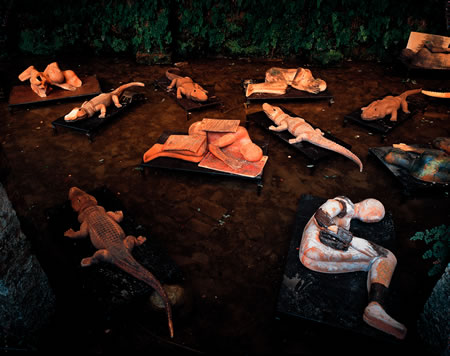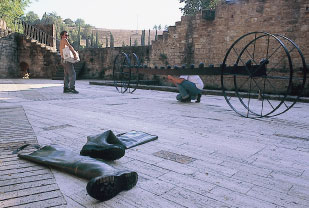
 |
||||||||||||||||||||||||||||
| Several terracotta
sculptures, some portraying crocodiles, some men in a fetal position,
have been placed on dark squared tables. Each sculpture’s colour
is slightly different from the others, according to the kind of earth
and the mixing materials used: sand, oxides and other casually or instinctively
chosen elements. Each one of the ‘sleepers’ and its table has
been placed in the impoundment on the back of the fountain. The front
of the fountain is constitued by 6 large pointed arches so the works are
visible leaning out of the parapet of the arcades. The Fountain of the
Fairies, built in the XII century, is continuosly fed by water filtering
down from the above land and is therefore changing its level according
to the rain. This means that the sculptures, normally about 10cm above
the water level, could also be partially submerged by water. The casual positioning of the sculptures, together with the rigid shape of the tables, gives to the basin the likeness of a picture, at once geometrical and floating. Musk and vegetation covering the walls of the fountain, the ticking of water drops dripping form its walls, all suggest a primeval atmosphere. The fountain is a womb where various primordial life forms are immerged in their amniotic fluid: reptiles and men in fetal position, sometimes covered by a kind of placenta, sometimes fragmented and somehow re-composed. The ruins appearance is linked to what is far, subconscious, lost in our ontogenetic and philogenetic roots. |
|
|||||||
| "I Dormienti" by Mimmo Paladino is now a permanent exhibition - Arte all'Arte 2000 - visit it | ||||||||
 |
Other signs that hint to digging into our collective and individual history are a stylized carriage with several small faces on its axle and a giant helmet, both in bronze, placed on the squared space in front of the arcades. In the sacristy of the nearby church of Saint Lucchese, Paladino placed three paintings: their formal structure comes from the background of the formelle painted by Memmo di Filippuccio for the furnitures of this sacristy. The artist didn’t consider important that the formelle were not visible by the public because he thought the homage to the work of art that inspired his work more relevant; beside, he appreciated the fact that they were closed to the public but in a place of daily use. |
|||||||
 The
last part of Paladino’s intervention is constituted by some sculptures,
10 pictures and 40 drawings with sword-shaped frames, all at the Cassero
di Poggio Imperiale - a fortress ordered by Lorenzo de’ Medici to Sangallo
and a probable prototype for the Belvedere fortress in Florence. The imposing
building, built for military reasons and abandoned about 60 years ago, has
been cleared and cleaned for this occasion, as an attempt to bring it under
public visibility and therefore stimulate its restoration. The
last part of Paladino’s intervention is constituted by some sculptures,
10 pictures and 40 drawings with sword-shaped frames, all at the Cassero
di Poggio Imperiale - a fortress ordered by Lorenzo de’ Medici to Sangallo
and a probable prototype for the Belvedere fortress in Florence. The imposing
building, built for military reasons and abandoned about 60 years ago, has
been cleared and cleaned for this occasion, as an attempt to bring it under
public visibility and therefore stimulate its restoration. |
||||||||
| © Arte Continua 1996-2002. Per le opere il © copyright è degli artisti | |||||||||